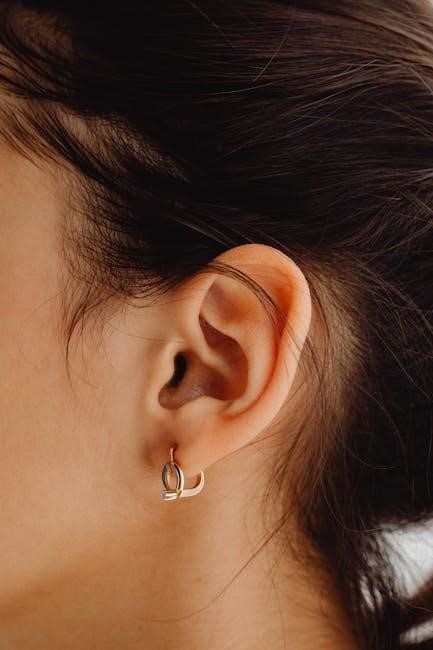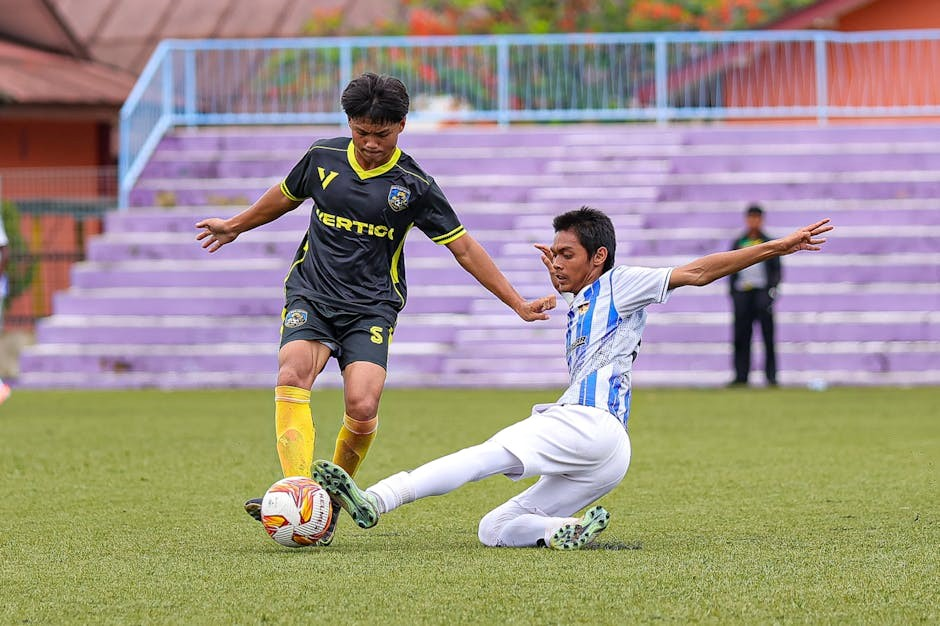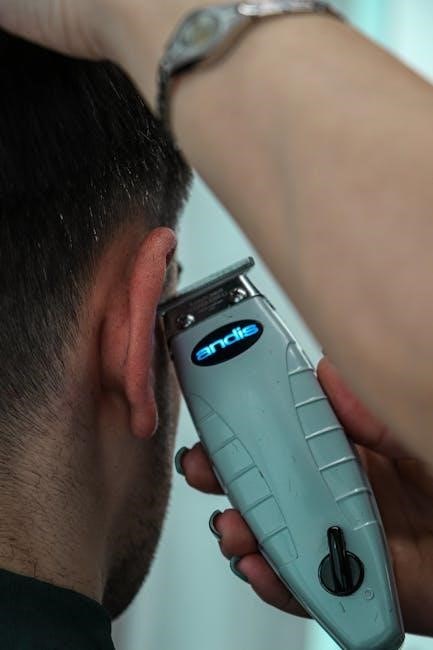
epley maneuver left ear pdf
The Epley Maneuver, developed by Dr. John Epley in 1992, is a series of head and body movements designed to treat Benign Paroxysmal Positional Vertigo (BPPV). It works by relocating otoconia, small calcium particles, from the semicircular canals to the utricle, where they no longer cause vertigo. This non-invasive technique is highly effective and can be performed in a clinical setting or at home with proper guidance. The maneuver is customized based on whether the left or right ear is affected, ensuring targeted relief from symptoms.
1.1 Definition and Purpose
The Epley Maneuver, or Canalith Repositioning Procedure (CRP), is a non-invasive technique designed to treat Benign Paroxysmal Positional Vertigo (BPPV). Its primary purpose is to relocate otoconia (calcium particles) from the semicircular canals to the utricle, where they no longer trigger vertigo. This method is particularly effective for posterior canal BPPV and can be tailored for the left ear, providing targeted relief from dizziness and imbalance.
1.2 Brief History of the Epley Maneuver
The Epley Maneuver was first described by Dr. John Epley in 1992 as a treatment for Benign Paroxysmal Positional Vertigo (BPPV). Initially studied in the early 1990s, it gained recognition for its effectiveness in relocating otoconia. Over the years, the technique has been refined and is now a widely accepted treatment for BPPV, particularly for the posterior semicircular canal variant.
Understanding Benign Paroxysmal Positional Vertigo (BPPV)
BPPV is a vestibular disorder caused by otoconia in the semicircular canals, leading to vertigo triggered by head movements. It is the most common cause of vertigo.
2.1 What is BPPV?
Benign Paroxysmal Positional Vertigo (BPPV) is a vestibular disorder caused by otoconia, small calcium particles, in the semicircular canals of the inner ear. These particles disrupt normal fluid movement, leading to vertigo triggered by specific head movements. Symptoms include brief, intense dizziness, often with nausea. It is the most common cause of vertigo and, while distressing, is generally not serious or indicative of a severe underlying condition.
2.2 Causes of BPPV
BPPV occurs when otoconia, small calcium particles in the inner ear, become dislodged and migrate into the semicircular canals, disrupting normal fluid movement. Common causes include head injuries, aging, viral infections, or ear surgery. It can also result from prolonged bed rest or certain positions, such as bending or rolling over. These events trigger the otoconia to move abnormally, leading to vertigo symptoms.
2.3 Symptoms of BPPV
BPPV is characterized by brief, intense episodes of dizziness or vertigo, often triggered by specific head movements, such as turning, lying down, or sitting up quickly. Symptoms may include nausea, vomiting, and balance difficulties. The dizziness typically lasts seconds to minutes and can vary in severity. These episodes are positional, meaning they are linked to particular head positions, and may improve with rest or specific maneuvers like the Epley Maneuver.

The Role of the Epley Maneuver in Treating BPPV
The Epley Maneuver is a non-invasive technique that effectively treats BPPV by relocating otoconia from the semicircular canals to the utricle, eliminating vertigo symptoms and restoring balance.
3.1 How the Epley Maneuver Works
The Epley Maneuver works by guiding calcium particles (otoconia) from the semicircular canals into the utricle, where they no longer cause vertigo. It involves a series of precise head and body movements, leveraging gravity to relocate these particles. The process begins with the patient sitting upright, turning their head, and then lying down in specific positions to allow the otoconia to move through the ear structures. Each step is designed to ensure the particles are safely repositioned, providing relief from BPPV symptoms.
3.2 Effectiveness of the Epley Maneuver
The Epley Maneuver is highly effective for treating BPPV, with studies showing an 80-90% success rate. It works best for posterior canal BPPV and can provide immediate relief in many cases. The procedure is non-invasive, pain-free, and suitable for most patients. While it is highly successful, outcomes may vary, and some individuals may require multiple sessions or alternative treatments if symptoms persist or if other conditions are present.
Steps of the Epley Maneuver for the Left Ear
Sit up, turn head 45 degrees left, lie down quickly, and hold 30 seconds. Repeat three times daily until vertigo-free for 24 hours. Follow guidance carefully for best results.
4.1 Preparing for the Maneuver
Before starting, discuss the procedure with your healthcare provider to confirm the affected ear. Sit upright with your head turned 45 degrees to the left. Remove any loose items that may interfere. Ensure a quiet, safe space to perform the maneuver. Avoid eating heavily beforehand. Be prepared to experience temporary dizziness during the process. Perform the maneuver up to three times daily as directed.
4.2 Step-by-Step Guide for the Left Ear
Sit upright with your head turned 45 degrees to the left. Quickly lie down, keeping your head in the same position, and remain still for 30 seconds. Slowly sit up and turn your head to the right. Lie down again, turning your head 45 degrees to the right, and wait another 30 seconds. Repeat this process up to three times daily until symptoms subside for 24 hours;
4.3 Frequency and Duration of the Maneuver
The Epley Maneuver for the left ear should be performed three times daily. Each session involves a series of specific head movements, with pauses of 30 seconds between steps. Continue the exercises until vertigo symptoms have been absent for 24 hours. Consistency is key for effectiveness. Your healthcare provider may adjust the frequency based on your progress and symptoms.

Differences Between Left and Right Ear Treatments
The Epley Maneuver differs for left and right ears due to anatomical direction. Head movements and body turns are mirrored, with left ear treatments involving opposite rotations compared to the right ear, ensuring proper otoconia relocation.
5.1 Anatomical Considerations
The Epley Maneuver accounts for anatomical differences between left and right ears, focusing on the semicircular canals’ orientation. The procedure involves specific head turns and body rotations to guide otoconia through the canals. For the left ear, movements are mirrored compared to the right, ensuring proper particle relocation without causing further imbalance. This customization addresses the unique anatomy of each ear.
5.2 Adjustments for the Left Ear
For the left ear, the Epley Maneuver involves turning the head 45 degrees to the left and performing specific body rotations. The patient sits up on the left side, tilts their head slightly back, and rolls onto their back, holding each position until dizziness subsides. This sequence is repeated three times daily, ensuring otoconia are effectively relocated from the affected canal.

Related Maneuvers and Techniques
The Semont maneuver and Dix-Hallpike test are techniques related to the Epley maneuver, aiding in diagnosing and treating BPPV by addressing otoconia displacement in the inner ear;
6.1 The Semont Maneuver
The Semont maneuver is a therapeutic technique used to treat BPPV by moving otoconia from the semicircular canals to the utricle. It involves a series of quick, gentle movements, differing from the Epley maneuver by using a more dynamic approach. The Semont maneuver is often recommended for patients who cannot tolerate the Epley maneuver or when it is ineffective; It is typically performed by a healthcare provider and can provide significant relief from vertigo symptoms.
6.2 The Dix-Hallpike Test
The Dix-Hallpike test is a diagnostic tool used to identify benign paroxysmal positional vertigo (BPPV). It involves turning the patient’s head 45 degrees to one side and then quickly lowering them into a supine position. The test observes nystagmus (eye movements) and vertigo symptoms, helping to confirm the presence and affected ear. It is a key assessment method for clinicians to diagnose BPPV and guide appropriate treatment.
Self-Treatment and Home Exercises
7.1 Can the Epley Maneuver be Performed at Home?
The Epley maneuver can be performed at home with proper guidance. It involves specific head and body movements to alleviate vertigo symptoms, customized for the left ear.
The Epley maneuver can be performed at home with proper guidance from a healthcare provider. Patients are advised to sit up, turn their head 45 degrees to the left, and lie down quickly, holding the position until dizziness subsides. This exercise should be repeated three times daily until symptoms resolve for 24 hours. Proper technique is essential for effectiveness.
7.2 Safety Precautions for Self-Treatment
When performing the Epley maneuver at home, ensure proper technique to avoid worsening symptoms. Start with a clean, flat surface and avoid sudden movements. Perform the maneuver as directed by your healthcare provider, typically three times daily. Wait 10-15 seconds between steps to allow dizziness to subside. Avoid activities that could dislodge otoconia, such as heavy lifting or bending. If symptoms persist or worsen, consult a professional immediately.

Success Rates and Recovery
The Epley maneuver is highly effective, with success rates of 70-90% after 1-3 sessions. Most patients experience relief within a few days to a week. Consistency is key for optimal recovery.
8.1 Expected Outcomes
Patients typically experience significant reduction in vertigo symptoms within a few days. Success rates for the Epley maneuver are high, with 70-90% of individuals achieving relief after 1-3 sessions. Complete resolution often occurs within one week. Consistent performance of the maneuver and adherence to post-treatment precautions enhance recovery outcomes, restoring balance and reducing dizziness effectively.
8.2 Time to Recovery
Most patients experience improvement in vertigo symptoms within 24-48 hours after the Epley maneuver. Full recovery typically occurs within 1-2 weeks, with some individuals noticing immediate relief. A small percentage may require additional sessions. Adherence to post-treatment precautions, such as avoiding head movements, can significantly accelerate recovery and prevent recurrence of symptoms.

When to Consult a Healthcare Provider
Consult a healthcare provider if symptoms persist, worsen, or are accompanied by severe dizziness, nausea, or hearing loss. Seek professional advice for proper diagnosis and treatment guidance;
9.1 Signs of Complications
Signs of complications during or after the Epley maneuver include severe dizziness, persistent nausea, vomiting, or hearing loss. If symptoms worsen or new issues arise, such as severe vertigo or imbalance, seek immediate medical attention. These signs may indicate unresolved BPPV, underlying conditions, or procedural complications, requiring further evaluation and treatment by a healthcare professional.
9.2 Persistent Symptoms After Treatment
If vertigo or dizziness persists after performing the Epley maneuver, it may indicate incomplete resolution of BPPV or other underlying conditions. Consult a healthcare provider if symptoms linger for more than a week or worsen. They may recommend repeating the maneuver, additional exercises, or further evaluation to rule out other causes of vertigo, ensuring proper management and relief from symptoms.

Post-Treatment Precautions
After undergoing the Epley maneuver, avoid activities like heavy lifting and sudden head movements. Refrain from sleeping on the treated ear to prevent dislodging particles and ensure proper recovery.
10.1 Activities to Avoid
After performing the Epley maneuver, it’s crucial to avoid activities that could dislodge the otoconia. This includes heavy lifting, bending, or turning your head sharply. Refrain from sleeping on the treated ear and avoid strenuous exercises for at least 24 hours. These precautions help ensure the particles remain in their correct position, promoting effective recovery and preventing vertigo recurrence.
10.2 Lifestyle Adjustments
Post-Epley maneuver, adopt a lifestyle that supports recovery. Sleep on your unaffected side using a pillow to elevate your head. Avoid heavy lifting, bending, or sudden head movements. Maintain a balanced diet and stay hydrated to overall well-being. Regular, gentle exercises can improve balance and stability, while stress reduction techniques may alleviate dizziness. These adjustments promote long-term relief and prevent vertigo recurrence.

Supplementary Exercises for Vertigo Relief
Eye and head exercises, such as gaze stabilization, improve balance and reduce dizziness. Gentle neck stretches and core-strengthening activities enhance stability, aiding overall vertigo management effectively.
11.1 Eye and Head Exercises
Eye and head exercises, such as gaze stabilization and tracking movements, complement the Epley maneuver by improving vestibular-ocular coordination. These exercises help reduce dizziness and enhance balance by strengthening the connection between eye movements and head positioning, making daily activities less challenging for individuals with vertigo. Regular practice can significantly improve symptoms and overall stability, aiding in long-term recovery and management of BPPV.
11.2 Balance and Stability Exercises
Balance and stability exercises, such as standing on one leg or using a foam pad, help improve vestibular function and overall equilibrium. These exercises strengthen core muscles and enhance proprioception, reducing dizziness and the risk of falls. Activities like heel-to-toe walking or sitting/standing with eyes closed can also be beneficial. Regular practice boosts confidence and independence, aiding in the recovery process and improving quality of life for individuals with vertigo.

Case Studies and Real-Life Examples
Real-life examples highlight the Epley maneuver’s effectiveness in resolving vertigo. Patients often report significant improvement, showcasing its practical benefits and positive impact on daily activities.
12.1 Successful Outcomes
Studies demonstrate the Epley maneuver’s high success rate in resolving BPPV symptoms. Many patients experience immediate relief, with vertigo significantly reduced after just one session. Real-life examples show improved quality of life, enabling individuals to resume daily activities without dizziness. The maneuver’s effectiveness lies in its ability to relocate otoconia, providing long-term relief for most patients, especially when performed correctly under professional guidance or at home with proper instruction.
12.2 Lessons Learned
The Epley maneuver’s effectiveness has been confirmed, but proper technique and adherence to post-treatment precautions are crucial. Patient compliance with daily exercises and follow-ups significantly improves outcomes. Over time, healthcare providers have learned to emphasize the importance of individualized treatment plans and clear instructions for at-home maneuvers. These insights ensure better symptom resolution and reduced recurrence rates for BPPV patients.

The Role of Technology in BPPV Treatment
Technology, such as apps and virtual reality tools, aids in guiding patients through exercises like the Epley maneuver, enhancing treatment accuracy and improving recovery outcomes for BPPV.
13.1 Apps for Guided Exercises
Apps like aVOR and Epley Maneuver Guide provide step-by-step instructions for performing the Epley maneuver, offering real-time feedback and customization for left or right ear treatment. These tools enhance patient engagement and adherence, ensuring proper technique and consistency. They also include timers, visual aids, and symptom tracking, making home treatment more accessible and effective for BPPV patients.
13.2 Virtual Reality and Rehabilitation Tools
Virtual reality (VR) is emerging as a powerful tool in BPPV rehabilitation, offering immersive environments to guide patients through exercises like the Epley maneuver. These tools simulate movements, helping patients visualize and perform techniques accurately. VR also tracks progress and provides feedback, enhancing adherence and effectiveness. Such innovations are transforming traditional rehabilitation methods, making them more engaging and accessible for patients with vertigo.
Future Directions in BPPV Treatment
Future advancements may include personalized treatments, advanced diagnostic tools, and innovative therapies. Research into underlying causes and technological integrations, like VR, will likely enhance BPPV management.
14.1 Emerging Techniques
Emerging techniques in BPPV treatment include the integration of virtual reality for guided exercises and the development of wearable devices to assist in performing the Epley maneuver accurately at home. Additionally, advancements in AI for personalized treatment plans are being actively explored to enhance the effectiveness of the Epley maneuver.
14.2 Research and Development
Research focuses on enhancing the Epley maneuver’s efficacy through improved techniques and understanding of BPPV. Clinical trials are optimizing outcomes by refining procedural steps and minimizing recurrence rates. Technological advancements, such as AI-driven diagnostic tools and VR-based rehabilitation, are being explored to aid in treatment. These developments aim to improve accessibility and success rates for patients worldwide, ensuring better management of vertigo symptoms.
The Epley maneuver remains a cornerstone in treating BPPV, offering effective relief through simple, non-invasive techniques. Its impact on improving patient outcomes underscores its significance in clinical practice.
15.1 Summary of Key Points
The Epley maneuver is a non-invasive treatment for BPPV, involving specific head movements to relocate otoconia. It is effective for both left and right ear cases, offering significant relief from vertigo. The technique, developed by Dr. John Epley in 1992, is widely used due to its simplicity and high success rate. Patients often experience improvement after a few sessions, making it a preferred treatment option.
15.2 Final Thoughts on the Epley Maneuver
The Epley maneuver remains a highly effective, non-invasive treatment for BPPV, offering significant relief from vertigo symptoms. Its simplicity and high success rate make it a preferred method for both clinicians and patients. With proper guidance, it can be safely performed at home, empowering individuals to manage their condition independently. This technique has revolutionized BPPV treatment, providing lasting relief for countless individuals worldwide.